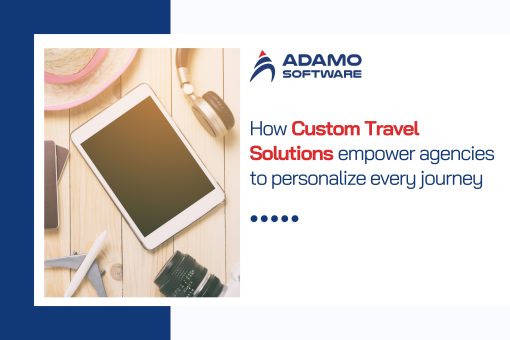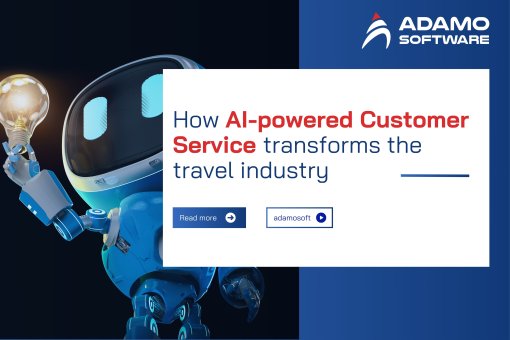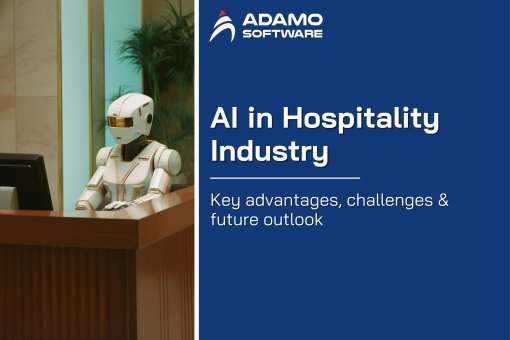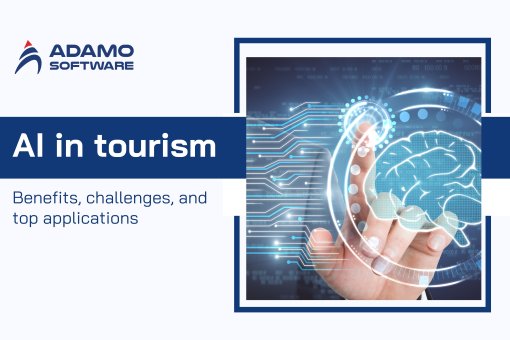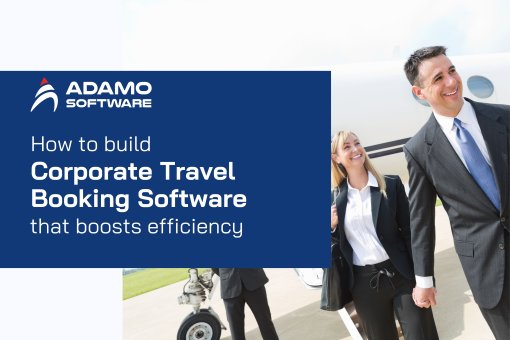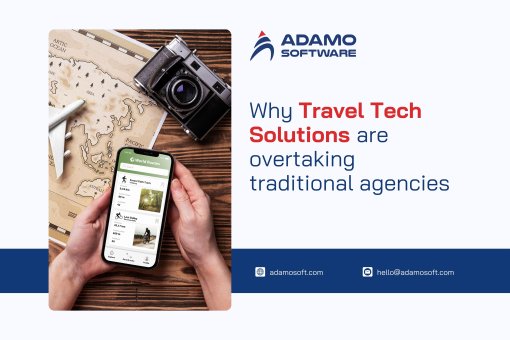Destination Management Software: Features, tips, and best use cases
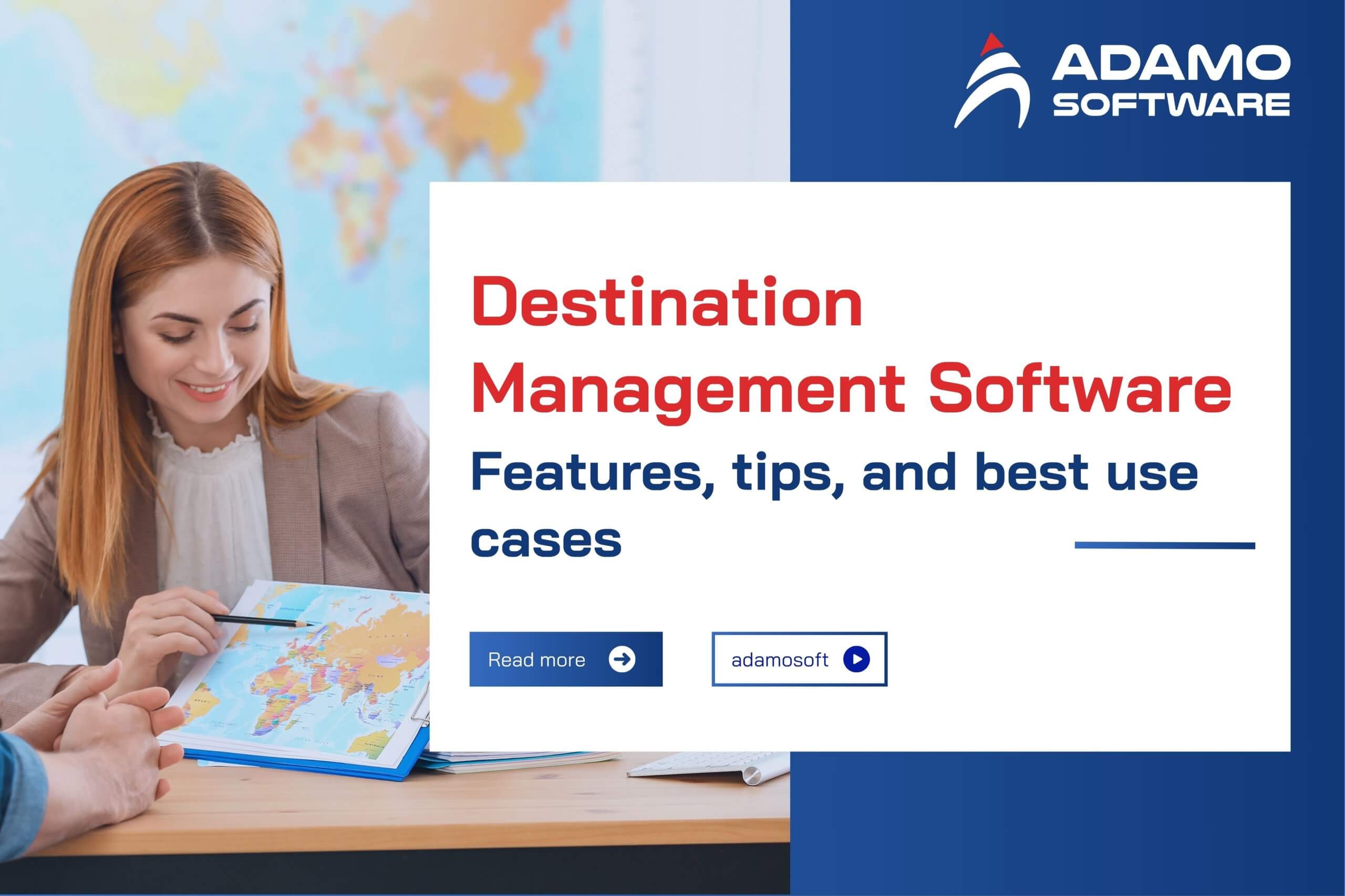
Destination management software has become an essential tool for travel companies. Let’s learn about the software with Adamo Software!
Currently, destination management has become an essential task for every country in developing tourism. To adapt to today’s high-speed travel environment, Destination Management Companies (DMCs) and travel agencies must have powerful and smart solutions for destination management software. So, what is this software and what are its must-have features? Let Adamo Software discuss these in detail.
Through this blog post, you will find some insights about destination management software and its characteristics. Besides, you will also know how to choose the best software and the best practices for the software. All information has been thoroughly researched and updated to the latest trends. So, let’s read our blog post and find some useful information!
I. What is Destination Management Software?
Destination management software is a system that streamlines various aspects of travel planning for a location. They include event scheduling, bookings, transportation, and accommodation. It helps DMCs and travel agencies monitor, arrange, and promote a destination effectively.
The software offers seamless XML and third-party API integration. Besides, it supports multiple languages and currencies, offers streamlined booking processes, simplifies product scheduling, and integrates with various payment gateways.
Destination management software offers tools for handling partner and service provider details, organizing tour schedules and events, tracking visitor data, and running marketing campaigns. Travel companies and DMCs can use the software to efficiently distribute their inventory to suppliers worldwide. Thanks to this, they can broaden their product ranges and reach a wider international audience. The destination management software facilitates the administration of diverse service purchases, enabling their seamless distribution to a global network of experts and destinations.
The software is not just a management tool. It is also a digital platform that connects all related stakeholders in the travel industry. They include local governments, travel agencies, tourists, etc. Destination management software allows DMCs and travel agencies to store and analyze the destination data in real-time. Thanks to this, they can make effective decisions based on the data collected. Additionally, this software also integrates digital marketing tools, manages service bookings, collects customer feedback, and measures the impact of promotional efforts.
Effective destination management software helps destinations define their brand, boost competitiveness, and significantly increase tourist arrivals. Besides, it also contributes to developing sustainable tourism as a destination. The software helps to monitor visitor traffic, manage resources reasonably, and preserve local cultural and natural values. So, which features must destination management software be provided? Let’s keep reading!
II. Must-have features of Destination Management Software
No matter if you are going to handle group tours, FIT bookings, or custom travel, the right destination management software is crucial for enhancing operational efficiency, precision, and profitability. Let’s explore the must-have features of destination management software with Adamo Software!
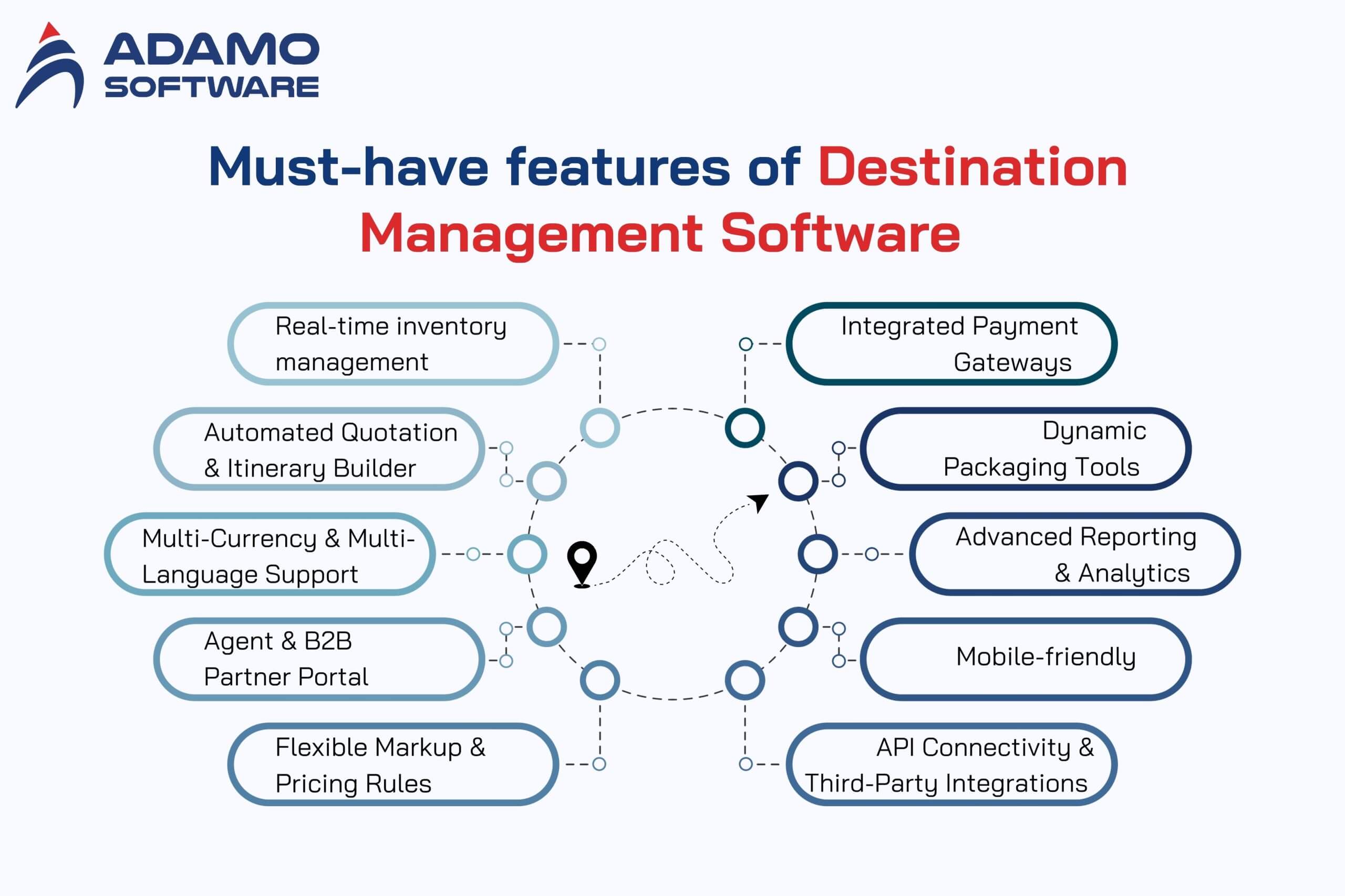
Real-time inventory management
Real-time inventory management is one of the most important features of destination management software. This feature allows DMCs and travel agencies to update and track real-time available services like hotel rooms, tour packages, transportation, etc. Thanks to this, they can avoid overbooking, duplicate bookings, or missing services. Besides, the software helps them coordinate and allocate resources more accurately. The system will automatically keep inventory data consistent across departments and sales channels.
With the real-time inventory management feature, the destination management software enables DMCs and travel companies to increase response speed and better serve customers. Agents can instantly access accurate service information, eliminating the need for time-consuming manual verification. This reduces risk and increases system reliability.
Automated Quotation & Itinerary Builder
Quoting and building an itinerary takes a lot of time. The faster the itinerary and prices are given to customers, the more satisfied they are. This decides the success of a DMC or travel agency in the travel industry. Thanks to the destination management software’s automated quotation and itinerary builder feature, travel companies and DMC can automate this process.
The destination management software will automatically choose services, time, and destination. Then, the system will create a detailed itinerary following your customers’ preferences and quote prices for each service and for the whole journey. This helps to save time and avoid errors.
Travel companies and DMCs may need effective destination management software that lets them quickly generate visually appealing, detailed quotations and itineraries. It must support customization to tailor packages precisely to client needs. The automated quotation and itinerary builder are essential for this.
You can explore more about Trip Planner App: Must-Have Features, Costs & Development Guide here.
Multi-Currency & Multi-Language Support
Travel agencies and DMCs may not operate in only their countries but globally. Thus, the multi-currency and multi-language support are needed for destination management software. This facilitates a broader reach, enhanced customer experience, and smooth financial dealings with global partners and clients. The system automatically adjusts service prices to the real-time exchange rate, ensuring transparent and convenient transactions.
Besides, this feature allows the travel companies and DMCs’ website/ app interface to convert into multiple languages, from English, French, etc., to the native languages. Thanks to this, customers can understand the services offered better.
Agent & B2B Partner Portal
The destination management software must have an agent and B2B partner portal. This enables B2B partners to manage their own bookings, check availability, and handle their operations. Thanks to this, travel agencies and DMCs do not need to manually process each request, optimizing resource use and empowering stakeholders.
B2B portal integration helps standardize workflows while increasing transparency and efficiency in collaboration. Besides, it also supports flexible commission programs and distinct discount policies for different partner groups. If you want to expand your distribution network, this feature is an indispensable tool. 2
Flexible Markup & Pricing Rules
The price for tour packages or services may vary based on customer requests, supplier prices, markets, seasons, customer types, etc. Thus, flexible markup and pricing rules are essential features of destination management software. Effective software must provide flexible markups, commission management, and discount rules for effective pricing and profitability control.
By configuring automatic markup, you can reduce errors and save time compared to manual calculations. The system also supports creating promotional programs, group prices, quantity prices, etc. to optimize revenue. This enables you to be more proactive in your pricing strategies.
Ready to Outsource?
Discover how we can transform your business with expert IT solutions.
Integrated Payment Gateways
Secure and seamless payment collection is essential for destination management software. This feature enables fast, secure online payments through payment gateways like Stripe, PayPal, local banks, or e-wallets. Payment gateway integration helps shorten the service booking process while increasing system reliability.
Besides supporting multi-currency payments, the system also complies with international security standards such as PCI DSS to ensure absolute payment processing security. All credit card information and sensitive data are encrypted to minimize fraud risk and protect user rights.
Dynamic Packaging Tools
With the dynamic packaging tools, the destination management software allows travel agencies and DMCs to tailor the tour package for customers. Instead of selling available tours, they can choose hotels, transportation, and sightseeing activities to create the package that customers like. This empowers DMCs to deliver unique experiences and maintain agility in product development.
Dynamic packaging helps travel agencies and DMCs increase their conversion rates by offering customers more flexible choices. Simultaneously, it boosts the average transaction value by effectively cross-selling additional services.
Advanced Reporting & Analytics
Every destination management software needs advanced reporting and analytics features to help travel agencies and DMCs make effective and accurate decisions. The software must have the ability to synthesize data from multiple sources and provide detailed reports on revenue, sales performance, customer volume, service booking frequency, and many other metrics. The display interface must be usually intuitive, featuring clear charts and dashboards.
Mobile-friendly
An effective destination management software must have a mobile-friendly interface, ensuring a smooth and fully functional experience. This feature allows travel agencies and DMCs to stay productive. The mobile-friendly interface lets operators check inventory, process orders, update tour information, or respond to partners from anywhere.
With this feature, the software can offer flexible management through web browsers or dedicated mobile and tablet applications. Thanks to this, travel companies and DMCs do not need to be dependent on offices or desktop computers. This allows them to enhance their flexibility and operational control.
API Connectivity & Third-Party Integrations
API connectivity and third-party integrations are also needed features of destination management software. The software must be able to integrate with external systems like CRM software, ERP, OTA platforms, accounting systems, and email marketing tools. This integration is done through APIs which allow for fast and accurate data exchange. This creates a centralized system that reduces manual input and boosts workflow efficiency.
Besides, these features also help to extend the system’s scope and increase its flexibility. For example, destination management software can sync with hotel partners for automatic rate and availability updates or integrate with AI tools to personalize user experiences.
III. How to choose the suitable Destination Management Software
By choosing effective destination management software, you can optimize operations and enhance customer experience. However, with many solutions available on the market, which software best suits your needs and scale of operations? Let Adamo Software recommend you how to choose the suitable destination management software.
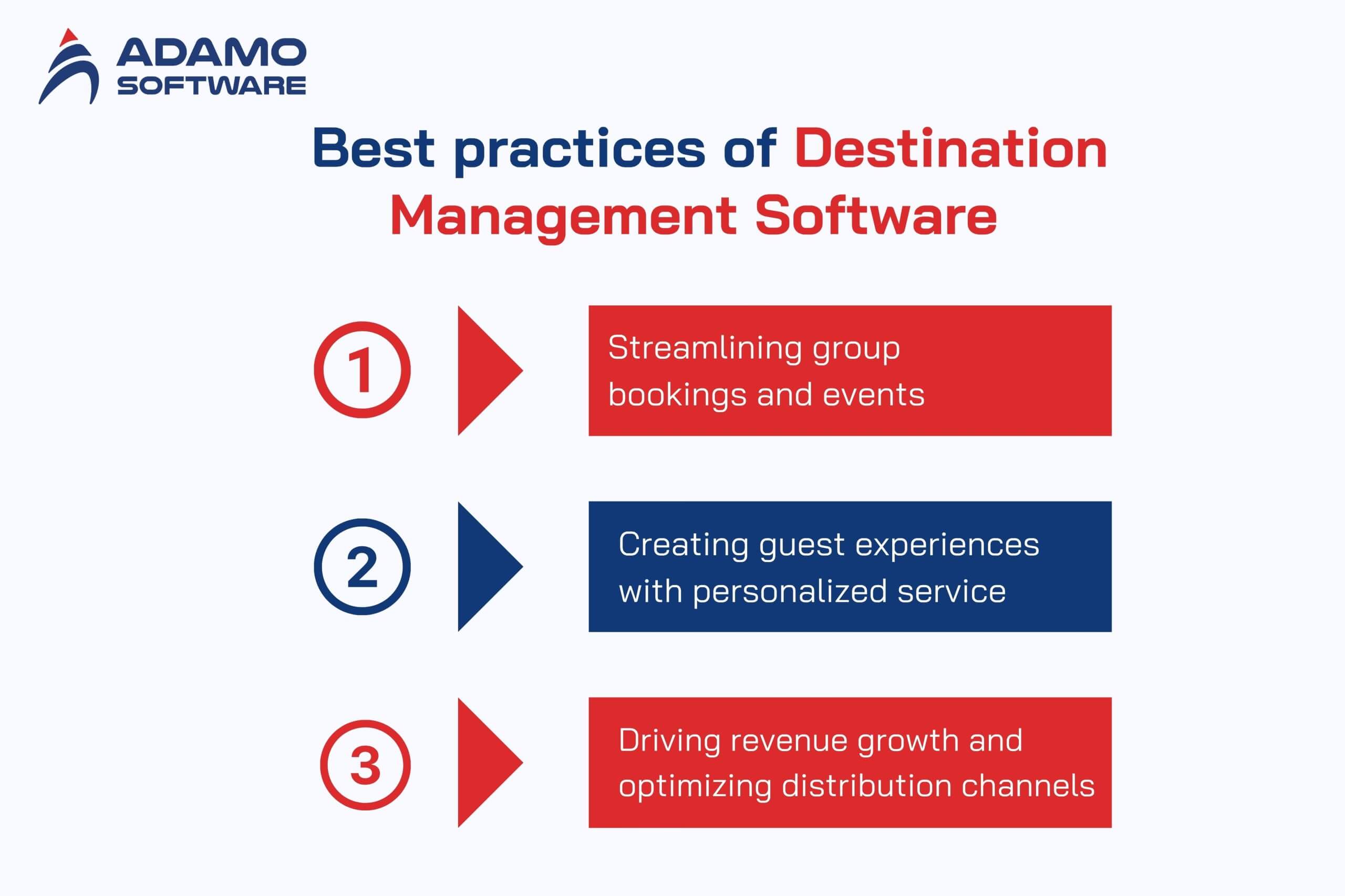
Defining your needs
Before choosing destination management software, you must identify your needs first. You may want to consider the type of service you offer. For example, your business may provide package tours, hotel reservations, transportation, or event planning. The management software will need different features for each type. When you know your needs and operating scope, you can avoid complex or inappropriate functions of the destination management software.
Defining your needs also involves evaluating your current size and future direction. If you want to expand to the international markets, you can add multi-language and multi-currencies features to your destination management software. If you are working with many partners, a robust B2B portal is essential.
Researching different options
Once you have defined your needs, it’s time for you to research various destination management software providers and their offerings. Let’s list reputable vendors and research their products through websites, brochures, demo videos, and user reviews. You may want to look for flexibility, stability, and scalability in the destination management software. By thoroughly researching, you can avoid choosing a solution that is inefficient or doesn’t meet your needs.
If you want to have a clearer view of each provider’s destination management software options, you may want to contact these providers and request a demo or trial period of the product. Thanks to this, you can evaluate the software’s interface, speed, and user-friendliness. You may also see the providers’ technical support and the software’s customization ability and integration with existing systems.
Checking out pricing plans
After researching different options and listing some providers based on preferences and considerations, you must look at each option pricing plans. Each software has different prices depending on the number of users, data capacity, or features. By comparing the prices of each service provider, you can calculate the investment costs of the software. Let’s consider hidden costs such as implementation fees, training, or annual maintenance fees.
You can choose between software that provides monthly subscriptions or a single license acquisition. You need to consider your business’s financial model to choose the most suitable option. If you’re a startup or small business, a flexible monthly payment plan can significantly reduce initial financial pressure. However, if you plan to use it for a long time, paying in full can be more economical in the long run.
In general, by identifying needs, researching various providers, and comparing prices thoroughly, you can choose a suitable destination management software for your business. The right software will streamline operations, enhance competitiveness, and foster sustainable growth for businesses in the current digital tourism environment.
IV. Best practices of Destination Management Software
Destination management software can only be effective when you know how to operate and optimize it properly. By adopting best practices and processes, you’ll improve work efficiency, reduce errors, and elevate the experience of partners and customers. Let’s find out the best practices of destination management software that travel companies should apply when deploying and using it.
Streamlining group bookings and events
Group tours and event management typically require substantial work and intricate coordination among various departments. You may want to use the destination management software to automate processes like tracking guest numbers, scheduling, dispatching vehicles, and allocating guides. This reduces manual errors, guaranteeing real-time consistency and updates for all information. As a result, businesses can serve more groups without increasing operational pressure.
In addition, DMS also supports the construction of schedules and quotes according to the requirements of each individual group. With flexible itinerary design tools and available service libraries, you can quickly create tour programs that suit each specific need. The tour template storage feature also saves time when processing similar future orders. This is especially useful for companies specializing in organizing MICE or periodic group tours.
Besides, the integration of detailed reporting and tracking in DMS makes it easy for managers to evaluate the effectiveness of each event or group tour. It provides insights into revenue, occupancy rates, guest satisfaction, and departmental performance. This data is crucial for improving services, optimizing costs, and elevating the quality of future event organization.
Creating unforgettable guest experiences with personalized service
Effective destination management software requires understanding and responding to guest preferences. Thanks to the software, you can easily store and analyze customer data such as preferences, tour booking history, special requests, or anniversaries. This enables you to make suitable itinerary suggestions, welcome gifts, or timely promotions, which contributes to enhancing customer satisfaction.
Besides tailoring customers’ journeys, destination management software can also be used to optimize customer communication. The system can send automatic emails, notifications via the application, or messages based on the customer’s name and specific tour booking information. Continuous engagement with guests’ pre-trip, during, and post-trip improves their overall experience. Simultaneously, feedback and reviews from customers are also recorded by the system to improve future services.
Ready to Outsource?
Get top-tier IT talent without the hassle. Contact us now!
Driving revenue growth and optimizing distribution channels
You can use destination management software to drive revenue growth and optimize distribution channels. The software allows businesses to expand their distribution network through multiple channels such as B2B agents, OTA partners, direct retail platforms, and integrated API systems. By centralizing and synchronizing product details across various channels, you can minimize errors, increase market penetration, and engage target customers more effectively. Simultaneously, the system also enables monitoring of each channel’s performance, allowing businesses to easily adjust their distribution strategies.
In addition, flexible pricing tools in the destination management software help optimize revenue based on customer type, seasonality, number of people traveling together, or time of booking. You can establish price-plus rules, create automatic discounts, or deploy promotions tailored to specific markets. This helps maintain competitiveness while ensuring healthy profit margins.
V. Partner with Adamo Software to bring your Destination Management Software to the next level
Are you looking for a partner to help you boost your destination management software’s efficiency? As one of Vietnam’s leading companies in travel and hospitality software development, Adamo Software can be your ideal choice. With experienced engineers and a deep understanding of DMC operations, Adamo can design and develop destination management software systems tailored to each business’s specific needs. Here’s how Adamo can help.

Developing core features of your destination management software
Adamo Software can develop core features of your destination management software. This helps you manage your tourism service chain effectively and accurately. A key feature is real-time inventory management, enabling businesses to constantly update the availability of hotel rooms, transport, tour guides, and related services.
Besides, Adamo also develops an automated itinerary and quote generator that allows sales staff to quickly build customized tour programs in just a few minutes. With this system, you can drag-and-drop services, see real-time estimated prices, and either publish PDF files or email them directly. Additionally, we also integrate multi-language and multi-currencies features if you operate worldwide. The Agent & B2B Partner Portal feature allows partners to log in, view products, check prices, create bookings, and track order status easily. Adamo designs all these features for flexibility, customization, and expandability, ensuring they meet the long-term development needs of your business.
Flexible customization
Using Adamo’s service, you can customize your destination management software instead of using available modules. Adamo approaches each project by carefully analyzing the client’s operating processes, business model, and long-term goals. This results in tailor-made software that addresses essential functions and offers scalability for future adjustments.
Adamo supports customization from the user interface, and business processes, to integration with the software ecosystem in use such as CRM, accounting, or customer care systems. This helps the software operate smoothly in the available environment, reduces training time, and increases efficiency for the human resources team.
Consulting technology strategy
Adamo will support you in analyzing your business needs, evaluating your capability, and identifying essential features for your destination management software. Choosing the right system architecture, platform technology, and deployment strategy will help you save significant costs, time, and effort in the long term. Besides, we also advise on how to integrate the DMS system with existing software such as accounting, CRM, ERP, customer care systems, or third-party APIs.
Deploying the destination management software
Adamo Software will help you deploy the software effectively, from idea generation to the stable operation of the system. The implementation process is carried out in clear stages: requirements survey, solution design, feature development, thorough testing, actual implementation, and user training.
Providing post-launch support
Even when the destination management software is put into operation, we still monitor and provide comprehensive maintenance and technical support services. This ensures that you can use the destination management software in the long term. Maintenance activities include regular software updates, system performance optimization, security checks, and technical troubleshooting. Adamo’s engineering team provides swift responses through a clear request-handling process, significantly reducing downtime and operational risks.
Still hesitating whether to choose Adamo Software? Let’s contact us for more detailed information!






